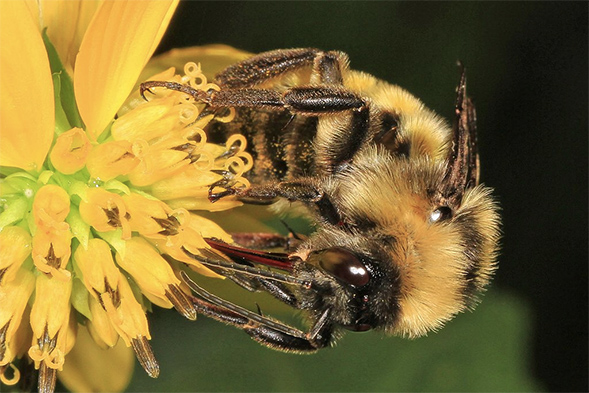
Bumble bees face different risks of disease transmission depending on which flowers they visit.
Farmers rely on bees to pollinate crops and increase yield, but certain flowers can transmit fatal parasites to the buzzers.
By Padma Nagappan in collaboration with North Carolina State University
Flowering strips – pollinator-friendly rows of plants that increase foraging habitat for bees – are known to help boost bee populations, but a new study finds they may also increase the risk of infection for the pollinators.
Researchers from San Diego State University, North Carolina State University and the University of Massachusetts Amherst found that flowering strip plants generally benefited bee colony reproduction by adding floral resources for common eastern bumble bees (Bombus impatiens).
But when bumble bees are exposed to certain plants they acquire higher rates of infection from a parasite, Crithidia bombi, which can reduce their foraging abilities and even kill bees deprived of sustenance.
“There is something about certain plant species that makes them hotspots for transmitting infections,” said Nicholas Barber, assistant professor of biology at SDSU and a co-author on the paper. “When an infected bee visits these flowers, they might leave the parasite behind to be picked up by the next visiting bee.”
The study, published in Proceedings of the National Academy of Sciences, showed certain “high-infection” plants doubled C. bombi infection intensity when compared with “low-infection” plant species.
Nonetheless, all bee colonies that foraged on flowering strips – both low-infection and high-infection types – showed increases in reproduction relative to bees that only had access to canola plants, an important U.S. crop. Low-infection plants included sunflower and thyme, while high-infection plants included swamp milkweed and purple loosestrife.
“We wanted to know the effects of flowering strip plant species on the health and reproduction of bumble bees,” said Rebecca Irwin, professor of applied ecology at NCSU and a study co-author. “Flowering strips are becoming more common as people look for ways to mitigate pollinator declines.”
The researchers used information gleaned from a previous study to split flowering strips into low- and high-infection portions. “In a prior study, we evaluated 15 plant species by putting the same amount of C. bombi on each, letting a bee forage, and then seeing whether and how bad of an infection it developed,” said Lynn Adler, professor of biology at UMass Amherst and the corresponding author of the paper. “We used that to designate plant species as ‘high/low infection’ for this study.”
The researchers placed bees in tents that contained the crop plants and flowering strips composed of either mostly high-infection plants, mostly low-infection plants or no flowering strips.
Depending on how critical the food supply is for the bees and how benign the pathogen in question is, the trade-off between more bees and higher pathogen infection rates may be acceptable.
However, if other pathogens are also seen to infect bees at similar rates, then planting flowering strips would need to be reexamined. But until then they recommend growers continue to plant the strips.
“On the one hand, these results tell us we need to take care to minimize additional risks for pollinators,” said Barber. “But they are also exciting because they show that flowering strips have great potential to support declining populations of native bees and ensure that we can continue to benefit from their services.”
Co-authors include Olivia M. Biller from Thomas Jefferson University. The study was funded by the U.S. Department of Agriculture’s Cooperative State Research Education and Extension Service as well as the USDA Agriculture and Food Research Initiative, the National Institutes of Health, and the National Science Foundation.